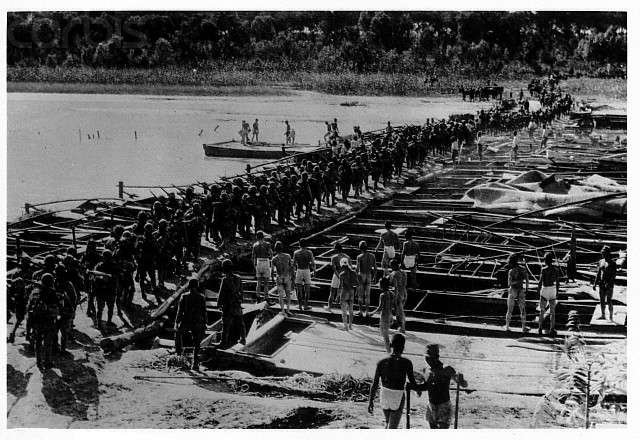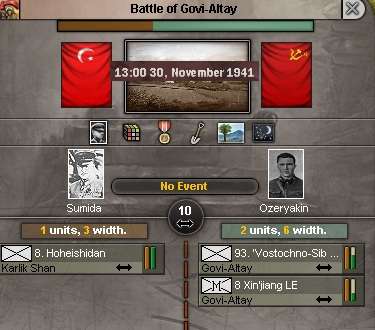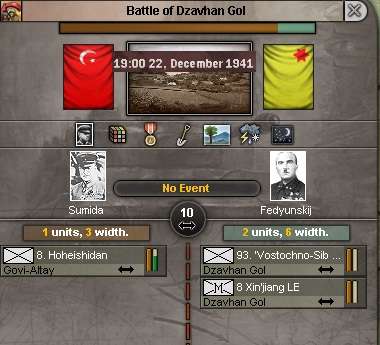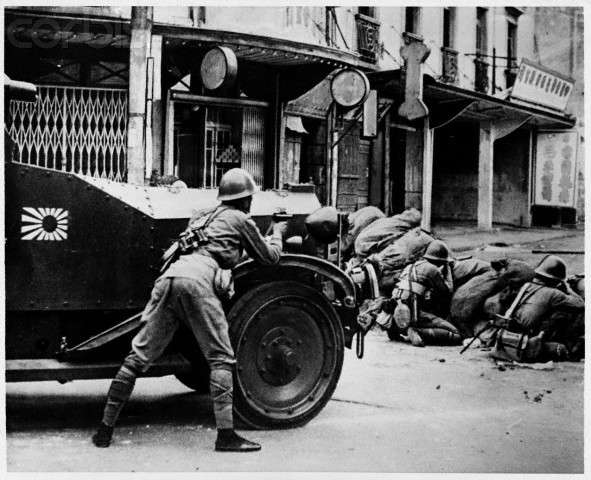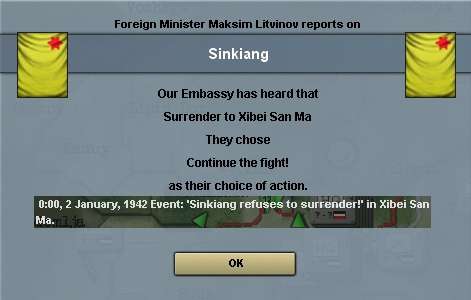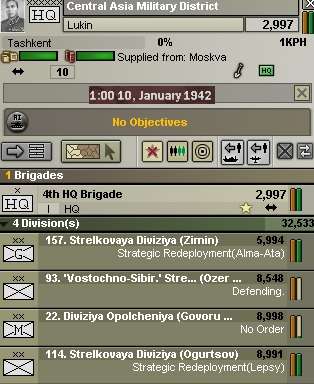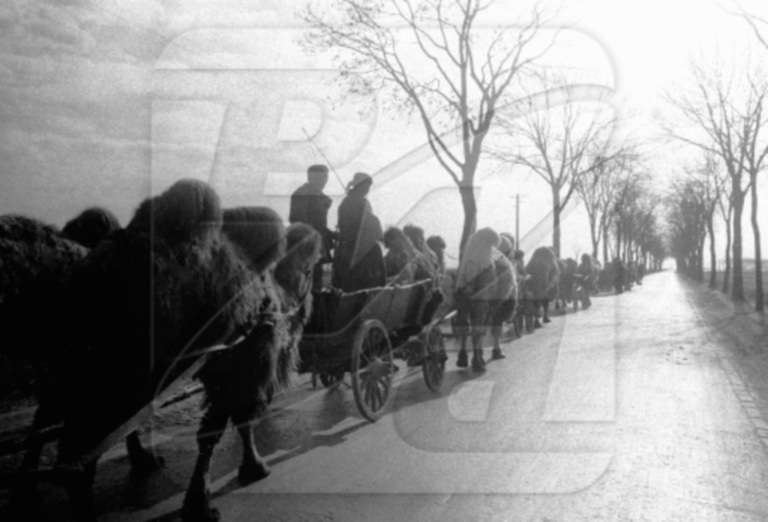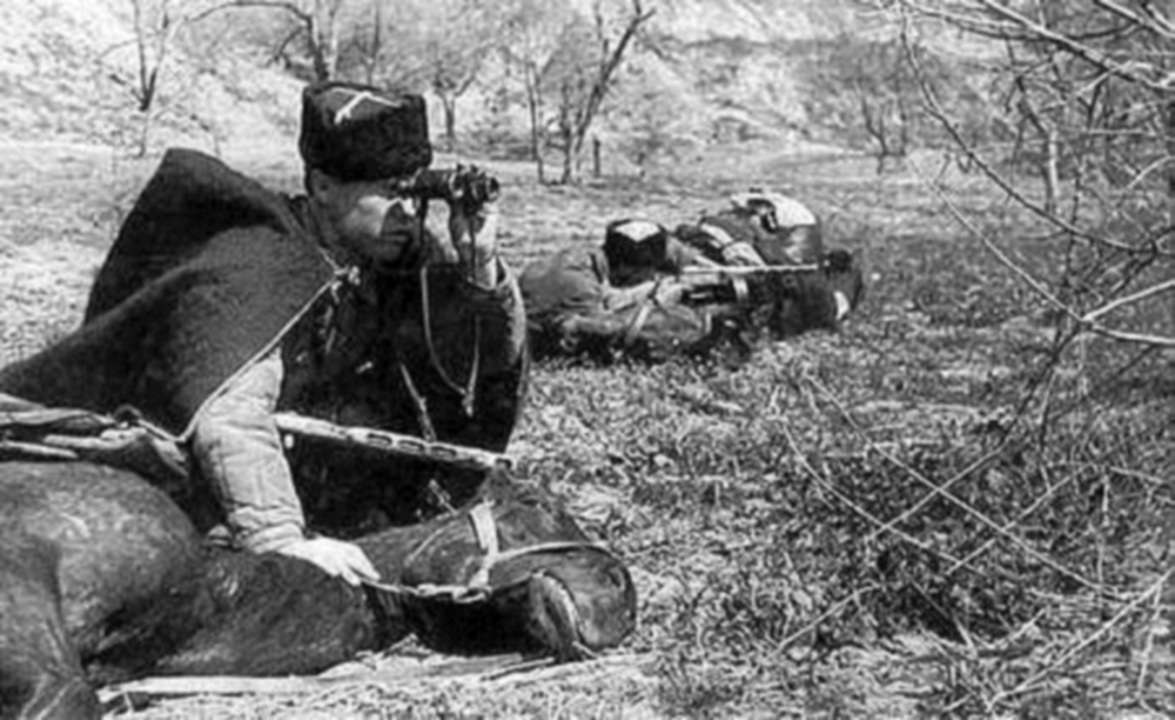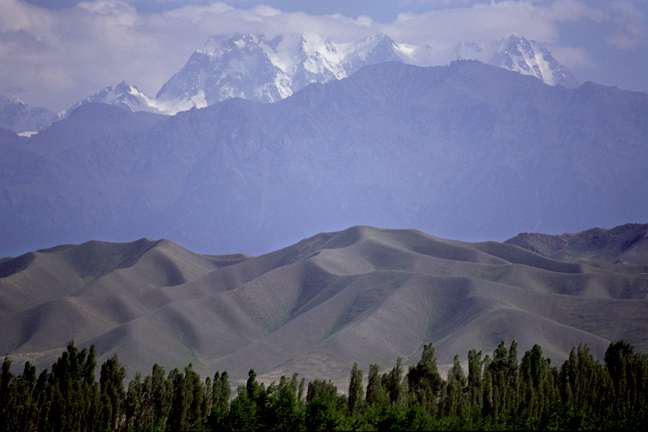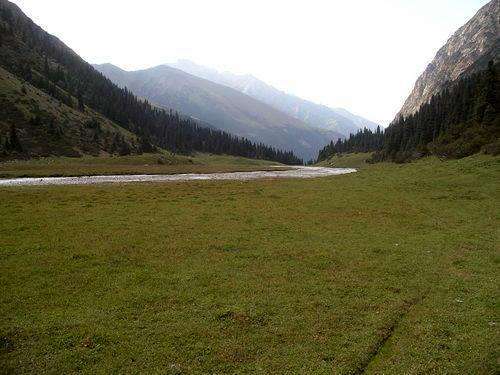Just as things seem to be going well in the European theatre, Japan begins to make a nuisance of herself in the east. I suppose the USSR's greatest defensive asset, its great size, is in this case also a hindrance, as said large size allows for attacks in a number of areas. Hopefully this Japanese incursion, or rather threatened incursion as both sides seem to be watching each other warily at present, will not cause any great trouble. Although your alluding to possible future ramifications in Persia seems to suggest otherwise. It makes for tense and gripping reading nonetheless.
This is nowhere near the magnitude or threat-level that the German invasion has, but at a time that you can barely hold the Hun in place, it is galling to have to scrape a force together to check the Japanese and their allies (and, apparently, get ready for Persia to join the Axis and invade - they're mightily close to Baku...).
Once Xibei & Guanxi hopped into the axis when Nat Chi collapsed I sort of expected some trouble in Central Asia, but my logic was it'd be a war between 2 loads on 1918 inf and militia, so a little low key intervention and sooner or later it'd work out ok.
Once Japan decided on war by proxy ... then the whole of Soviet Central Asia was at risk because if they pushed through the various bottlenecks then even with supply problems they had so many formations that I'd be overwhelmed.
I hope this secondary theater doesn't draw too much force away to put your counteroffensive on ice.
Just wondering why you only now stripped your defenses in Trans Baikal and near the Persian border bare of troops, instead of doing this much earlier and replacing the regular infantriedivisions in those area's with militia. Seems to me you could have put these divisions to good use either in the west holding the line against the German agressor, or in the east preempting a Japanese attack. Now they were sitting there idle for months while the bulk of your army was bleading dry in the defense of the Motherland.
The plot thickens ;D
Keep up the good work, the fact that you're even considering how to make a decisive counter attack is testament to the valiant Soviet defence, lets hope those Japanese don't draw away enough troops to postpone your counter-offensive and make you miss the window of opportunity.
The OOB for 1 March is not the end of my need to build up in the region. It becomes a steady drain of new formations and I also end up needing to shift some more over from the Caucasus. I reckon that indirectly this cost me Archangelsk as the troops that would have shored up that sector all end up in Central Asia.
In part I'm limiting myself a bit for a degree of role-playing. So I don't abandon things that the Soviet regime would have struggled to justify losing without a fight. I did a little bit of reorganising in the Far East, the 3 motorised rifle divs that start there I pulled over to Moscow, I juggled around between the Far East and Central Asia (so some Far East units went to Central Asia and the 2 Mtn Divs that start in Central Asia went to the West - wish I hadn't done that with hindsight) & I do allocate 3 of the Militia divs to the Far East (& later upgraded them to Rifle Divs).
But yes, in a few places (Murmansk is the worst), I made things rather hard for myself by trying to hold onto things I should have abandoned.
Interesting assortment of photos: the Japanese seem to deploy naked engineers, and Russian cavalry apparently uses their horses as cover. I wonder if they shoot the horses first, or if the horses are so well-trained that they can remain calm while a cavalrist fires his Shpagin right next to their ears...
Didn't notice the naked Japanese engineers in the top picture until Stuyvesant mensioned them, but it seems to me the Russian horses are alive. The cavalryman is using his weight to hold the neck of the animal down. Have to agree with Stuyvesant on the amount of training it would have requered to keep these animals down when their handler if firing his rifle over their heads. Unbelievable...!
Agree, they are just exceptionally good cavalry. The Soviets didn't carry on raising fresh cavalry divisions purely out of need. They knew they had a superb resource available & developed an organisational concept (the cav-mech group) that made the best use of them too.
I think the naked engineers may be *ahem* something not to be mentioned on these forums ... in effect the Japanese saw no reason to properly dress local labourers?
Personal pictures of the mountains? Truly from the mountains the claim to represent, or taking somewhere else?

Those aren't mine. But I have indeed climbed in the Tien Shan, once in 80s at the end of the Soviet era (they were started to invite members of western mountaineering groups over) and again at the end of the 90s. I'm probably one of the few people who have climbed both Fidel Castro (a very hard 'pass' on the Probeda ridge) and Maxim Gorki (the 'easy' peak next to Khan Tengri). Utterly fascinating place.
The pass is one of the lines through the mountains to Kazakhstan. The mountain picture is the main line of the Central Tien Shan. It really does look like that, a gradation from dusty low (2-3000m) hills, those below the snow line (around 4000m) with the snow caps behind.
Incredible,enemies at every corner but still the bear fights on!
What's ur production que btw?
Man, what a nightmare! You _need_ that peace and quiet in central Asia. Otherwise, no shock troops in nov and dec '41
impressive!
holding that much front-line must be quite hard.
At least the enemy cannot supply nor send much forces against thee.
For now...
Purely as game play this is the best I've had with HOI3, combination of a bit of tweaking, a far better AI, & the hard malus, all seem to have made it a real tussle. It never gets easy (at least not as far as I've played).
Heres the prod queue for 1 Dec:

In effect I'm still trying to balance stuff that I needed yesterday (rifle divs) with stuff that I know I really need as well (more armour/cas). I'd reverted back to the longest training time as the malus for under-trained formations is quite large. I'm also starting to do some upgrades (I ended up doing a lot of this, mostly mil-inf, inf/arm-gds etc).
The radar is a bit of a luxury at this stage, but it really pays off later on, I end up with a decent one at Leningrad and another at Sevastopol and excellent intelligence on movements behind the German lines.
The front line as 1 March was probably the last place where impassable terrain meant I could hold a solid front without too many units. If they get out of that area, then they'll spread all over Siberia and Central Asia.
Lets hope Japan/Xibei forces will have do deal with at least temporary lack of supply, hampering their effectiveness. At least I had some problems like that last time I fought in the area

But that was HoI3 1.4.
They had real supply problems. It wasn't till I loaded up as Guanxi to get the info for the post did I realise just how many Japanese troops were in theatre (there's about 12 divs at Di Hua). They have two problems - one is the supply line is poor (lots of 20% infra) and also the Xibei IC physically can't generate enough supplies. I noticed a lot of the AI changing Japanese units to Xibei and back again which I didn't really understand. I now think it was trying to keep them most as 'Japanese' as long as they weren't in combat, so Xibei only had to build supplies for a few.
Distractions, distractions. No wonder you are having problems concentrating forces for decisive blows.
You need some good maskirovka plans to achieve the necessary local superiority. Alas, HoI3 doesn't have deception units.
Much to my pleasure, I do later on pull off a real deception offensive. What looks like no more than just another skirmish over the Dniepr crossings, then once I had the West bank, pulled in two tank armies that had been sitting a couple of provinces back ...

That yielded a very satisying pocket.
I always like to hear about subsidiary fronts where small amount of troops have a big impact.
Looking at the map I have to refer again to my standard comment on the USSR/Russia - "It is very easy to conquer a whole lot of nothing".
The scale of that map is pretty awesome actually, it really does put the size of the USSR into context. My fear, as above, was if the Japanese/Xibei got out of the relative bottleneck of Sinkiang then they'd cut the Trans-Siberian & grab Central Asia, it'd take me masses of formations just to present some sort of coherent front. On the other hand its a lot of grass, tundra and desert they are planning to invade.
Ha, these Japanese are making a grave error in attacking the Motherland. They will pay the price later I hope.
My relations with the Japanese remain tense, and China keeps on producing new dynamics, but I daren't really go for the Japanese till I have Germany at least out the USSR, then I might risk sending enough to Siberia to allow me to attack Manchuria.


